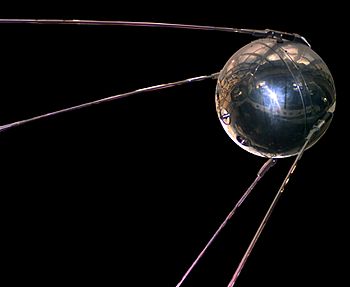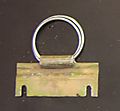Sputnik 1 facts for kids

Replica of Sputnik 1
|
|
| Names | Спутник-1 |
|---|---|
| Mission type | Technology demonstration |
| Operator | OKB-1 |
| Harvard designation | 1957 Alpha 2 |
| Mission duration | 21 days |
| Orbits completed | 1440 |
| Spacecraft properties | |
| Manufacturer | OKB-1 Ministry of Radiotechnical Industry |
| Launch mass | 83.6 kg (184 lb) |
| Dimensions | 58 cm (23 in) diameter |
| Power | 1 watt |
| Start of mission | |
| Launch date | 4 October 1957, 19:28:34 UTC |
| Rocket | Sputnik 8K71PS |
| Launch site | Baikonur 1/5 |
| End of mission | |
| Disposal | Orbital decay |
| Last contact | 26 October 1957 |
| Decay date | 4 January 1958 |
| Orbital parameters | |
| Reference system | Geocentric |
| Regime | Low Earth |
| Semi-major axis | 6,955 km (4,322 mi) |
| Eccentricity | 0.05201 |
| Perigee | 215 km (134 mi) |
| Apogee | 939 km (583 mi) |
| Inclination | 65.1° |
| Period | 96.2 minutes |
| Epoch | 4 October 1957, 15:12 UTC |
|
|
|
Sputnik 1 was the very first artificial (man-made) satellite to orbit our planet, Earth. The Soviet Union launched it on October 4, 1957, from a place called Baikonur Cosmodrome.
Sputnik 1 orbited Earth for about three months. During this time, it went around our planet 1,440 times. It had a radio transmitter that sent out beeping sounds. On January 4, 1958, Sputnik 1 fell back into Earth's atmosphere and burned up.
When the Soviet Union launched Sputnik 1, the United States was very surprised. They didn't want to fall behind in space exploration. This event made the U.S. spend more money on science and education. It also marked the start of the Space Race between the Soviet Union and the United States.
Contents
What Does "Sputnik" Mean?
The word Sputnik comes from the Russian word Спутник. It literally means "travelling companion."
How Sputnik 1 Changed the World
Sputnik 1 was a huge step for humanity. It showed that it was possible to launch objects into space. This opened the door for many more space missions.
The Start of the Space Race
The launch of Sputnik 1 kicked off the "Space Race." This was a competition between the United States and the Soviet Union. Both countries wanted to be the first to achieve new things in space. This included sending people to space and landing on the Moon.
Impact on Science and Education
After Sputnik 1, many countries, especially the United States, put more focus on science and math in schools. They wanted to make sure their students were ready for the future of space and technology.
What Did Sputnik 1 Do?
Sputnik 1 was a small, shiny sphere, about the size of a beach ball. It had four long antennas. Its main job was to send radio signals back to Earth.
The Beeping Sounds
People around the world could hear Sputnik's beeping sounds on their radios. These sounds were very simple, but they proved that the satellite was in orbit and working. Scientists used these signals to study how radio waves travel through Earth's atmosphere.
Gathering Information
Sputnik 1 also helped scientists learn about the density of the upper atmosphere. By tracking how the satellite's orbit slowly changed, they could figure out how much air resistance it was facing. This information was important for designing future spacecraft.
Related Pages
Images for kids
-
Last remaining piece of Sputnik 1: metal arming key which prevented contact between batteries and transmitter prior to launch; on display at the Smithsonian National Air and Space Museum
-
30 kopek USSR stamp depicting Sputnik 1 orbiting the Earth, the Earth orbiting the Sun and the Sun orbiting the centre of the Milky Way galaxy
-
Sputnik 1, Sergei Korolev and Valentin Glushko on a 2007 Ukrainian stamp
See also
 In Spanish: Sputnik 1 para niños
In Spanish: Sputnik 1 para niños







